An official website of the United States government
 United States Department of Labor
United States Department of Labor
Manually plant, cultivate, and harvest vegetables, fruits, nuts, horticultural specialties, and field crops. Use hand tools, such as shovels, trowels, hoes, tampers, pruning hooks, shears, and knives. Duties may include tilling soil and applying fertilizers; transplanting, weeding, thinning, or pruning crops; applying pesticides; or cleaning, grading, sorting, packing, and loading harvested products. May construct trellises, repair fences and farm buildings, or participate in irrigation activities. Excludes "Pesticide Handlers, Sprayers, and Applicators, Vegetation" (37-3012), "Graders and Sorters, Agricultural Products" (45-2041), and "Forest, Conservation, and Logging Workers" (45-4011 through 45-4029).
Employment estimate and mean wage estimates for Farmworkers and Laborers, Crop, Nursery, and Greenhouse:
| Employment (1) | Employment RSE (3) |
Mean hourly wage |
Mean annual wage (2) |
Wage RSE (3) |
|---|---|---|---|---|
| 293,910 | 1.8 % | $ 14.49 | $ 30,140 | 0.5 % |
Percentile wage estimates for Farmworkers and Laborers, Crop, Nursery, and Greenhouse:
| Percentile | 10% | 25% | 50% (Median) |
75% | 90% |
|---|---|---|---|---|---|
| Hourly Wage | $ 12.15 | $ 13.02 | $ 13.78 | $ 15.05 | $ 18.27 |
| Annual Wage (2) | $ 25,270 | $ 27,070 | $ 28,660 | $ 31,310 | $ 37,990 |
Industries with the highest published employment and wages for Farmworkers and Laborers, Crop, Nursery, and Greenhouse are provided. For a list of all industries with employment in Farmworkers and Laborers, Crop, Nursery, and Greenhouse, see the Create Customized Tables function.
Industries with the highest levels of employment in Farmworkers and Laborers, Crop, Nursery, and Greenhouse:
| Industry | Employment (1) | Percent of industry employment | Hourly mean wage | Annual mean wage (2) |
|---|---|---|---|---|
| Support Activities for Crop Production | 234,800 | 67.01 | $ 14.36 | $ 29,870 |
| Merchant Wholesalers, Nondurable Goods (4241, 4247, and 4249 only) | 14,400 | 2.69 | $ 14.27 | $ 29,670 |
| Lawn and Garden Equipment and Supplies Stores | 11,560 | 7.00 | $ 14.46 | $ 30,070 |
| Beverage Manufacturing | 5,800 | 2.22 | $ 16.51 | $ 34,330 |
| Services to Buildings and Dwellings | 2,680 | 0.13 | $ 14.16 | $ 29,460 |
Industries with the highest concentration of employment in Farmworkers and Laborers, Crop, Nursery, and Greenhouse:
| Industry | Employment (1) | Percent of industry employment | Hourly mean wage | Annual mean wage (2) |
|---|---|---|---|---|
| Support Activities for Crop Production | 234,800 | 67.01 | $ 14.36 | $ 29,870 |
| Lawn and Garden Equipment and Supplies Stores | 11,560 | 7.00 | $ 14.46 | $ 30,070 |
| Merchant Wholesalers, Nondurable Goods (4241, 4247, and 4249 only) | 14,400 | 2.69 | $ 14.27 | $ 29,670 |
| Beverage Manufacturing | 5,800 | 2.22 | $ 16.51 | $ 34,330 |
| Farm Product Raw Material Merchant Wholesalers | 1,010 | 1.47 | $ 17.80 | $ 37,010 |
Top paying industries for Farmworkers and Laborers, Crop, Nursery, and Greenhouse:
| Industry | Employment (1) | Percent of industry employment | Hourly mean wage | Annual mean wage (2) |
|---|---|---|---|---|
| Elementary and Secondary Schools | 110 | (7) | $ 23.41 | $ 48,690 |
| Grantmaking and Giving Services | (8) | (8) | $ 22.05 | $ 45,860 |
| Chemical Manufacturing (3251, 3252, 3253, and 3259 only) | 170 | 0.05 | $ 20.04 | $ 41,680 |
| Water, Sewage and Other Systems | 60 | 0.11 | $ 19.91 | $ 41,410 |
| Restaurants and Other Eating Places | (8) | (8) | $ 19.75 | $ 41,070 |
States and areas with the highest published employment, location quotients, and wages for Farmworkers and Laborers, Crop, Nursery, and Greenhouse are provided. For a list of all areas with employment in Farmworkers and Laborers, Crop, Nursery, and Greenhouse, see the Create Customized Tables function.
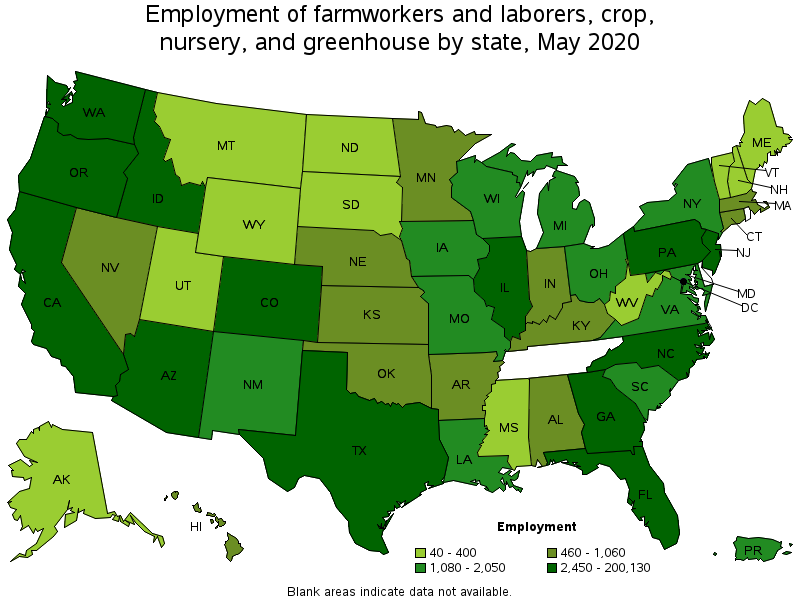
States with the highest employment level in Farmworkers and Laborers, Crop, Nursery, and Greenhouse:
| State | Employment (1) | Employment per thousand jobs | Location quotient (9) | Hourly mean wage | Annual mean wage (2) |
|---|---|---|---|---|---|
| California | 200,130 | 12.18 | 5.76 | $ 14.60 | $ 30,370 |
| Washington | 14,850 | 4.65 | 2.20 | $ 15.73 | $ 32,710 |
| Arizona | 10,090 | 3.56 | 1.68 | $ 14.17 | $ 29,480 |
| Florida | 9,140 | 1.08 | 0.51 | $ 11.83 | $ 24,600 |
| Oregon | 7,480 | 4.14 | 1.96 | $ 14.27 | $ 29,670 |
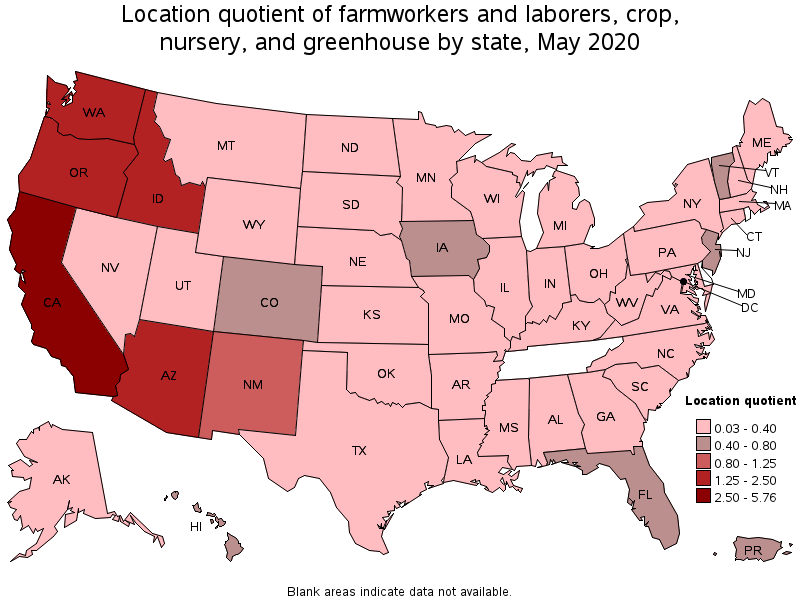
States with the highest concentration of jobs and location quotients in Farmworkers and Laborers, Crop, Nursery, and Greenhouse:
| State | Employment (1) | Employment per thousand jobs | Location quotient (9) | Hourly mean wage | Annual mean wage (2) |
|---|---|---|---|---|---|
| California | 200,130 | 12.18 | 5.76 | $ 14.60 | $ 30,370 |
| Washington | 14,850 | 4.65 | 2.20 | $ 15.73 | $ 32,710 |
| Oregon | 7,480 | 4.14 | 1.96 | $ 14.27 | $ 29,670 |
| Arizona | 10,090 | 3.56 | 1.68 | $ 14.17 | $ 29,480 |
| Idaho | 2,450 | 3.41 | 1.62 | $ 12.82 | $ 26,670 |
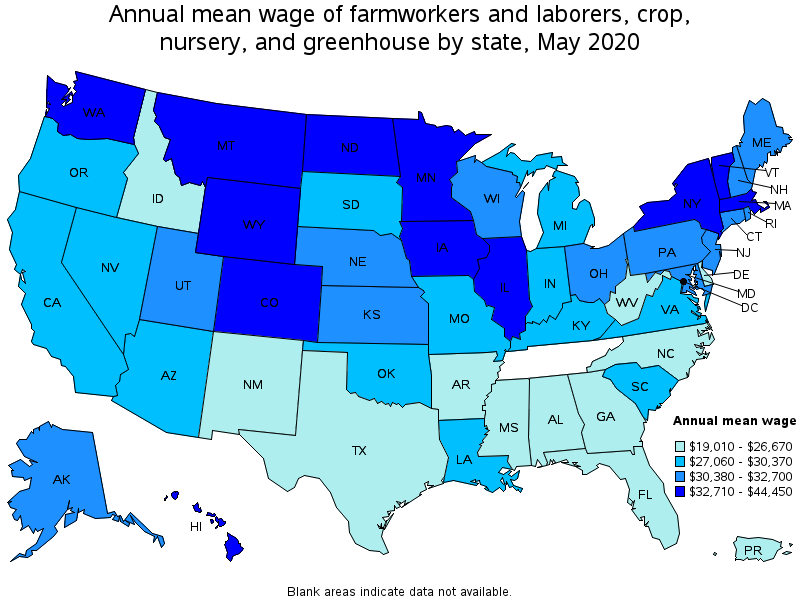
Top paying states for Farmworkers and Laborers, Crop, Nursery, and Greenhouse:
| State | Employment (1) | Employment per thousand jobs | Location quotient (9) | Hourly mean wage | Annual mean wage (2) |
|---|---|---|---|---|---|
| District of Columbia | 50 | 0.07 | 0.03 | $ 21.37 | $ 44,450 |
| Hawaii | 960 | 1.67 | 0.79 | $ 18.21 | $ 37,880 |
| Vermont | 240 | 0.84 | 0.40 | $ 17.87 | $ 37,170 |
| Wyoming | 40 | 0.16 | 0.08 | $ 17.78 | $ 36,990 |
| Minnesota | 880 | 0.33 | 0.15 | $ 16.98 | $ 35,320 |
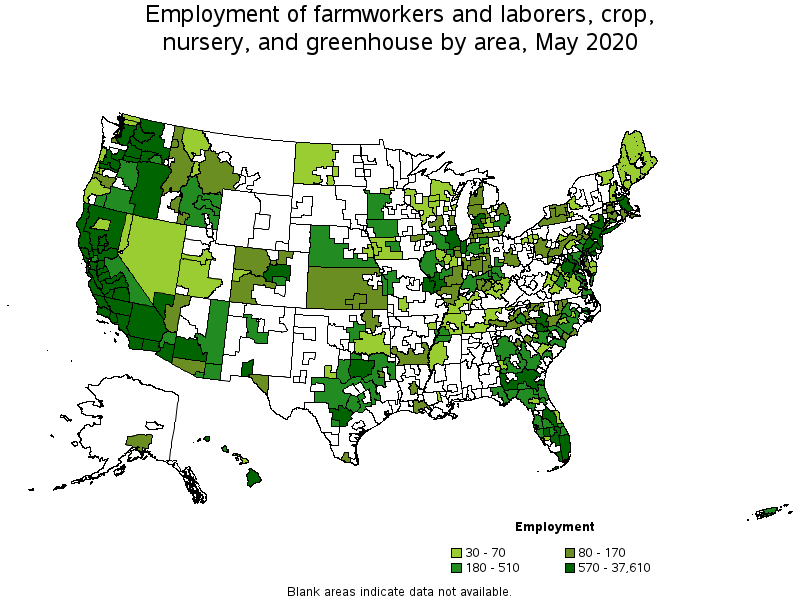
Metropolitan areas with the highest employment level in Farmworkers and Laborers, Crop, Nursery, and Greenhouse:
| Metropolitan area | Employment (1) | Employment per thousand jobs | Location quotient (9) | Hourly mean wage | Annual mean wage (2) |
|---|---|---|---|---|---|
| Bakersfield, CA | 37,610 | 123.15 | 58.29 | $ 13.80 | $ 28,700 |
| Salinas, CA | 32,940 | 192.11 | 90.92 | $ 15.63 | $ 32,510 |
| Fresno, CA | 24,250 | 64.45 | 30.50 | $ 13.86 | $ 28,840 |
| Visalia-Porterville, CA | 21,120 | 142.14 | 67.27 | $ 14.38 | $ 29,920 |
| Santa Maria-Santa Barbara, CA | 9,510 | 52.10 | 24.66 | $ 14.31 | $ 29,770 |
| Stockton-Lodi, CA | 8,460 | 34.12 | 16.15 | $ 14.59 | $ 30,350 |
| Madera, CA | 6,880 | 149.80 | 70.90 | $ 13.81 | $ 28,710 |
| Modesto, CA | 6,480 | 36.11 | 17.09 | $ 14.42 | $ 29,990 |
| Yuma, AZ | 6,370 | 105.01 | 49.70 | $ 13.68 | $ 28,450 |
| Riverside-San Bernardino-Ontario, CA | 6,370 | 4.27 | 2.02 | $ 14.43 | $ 30,020 |
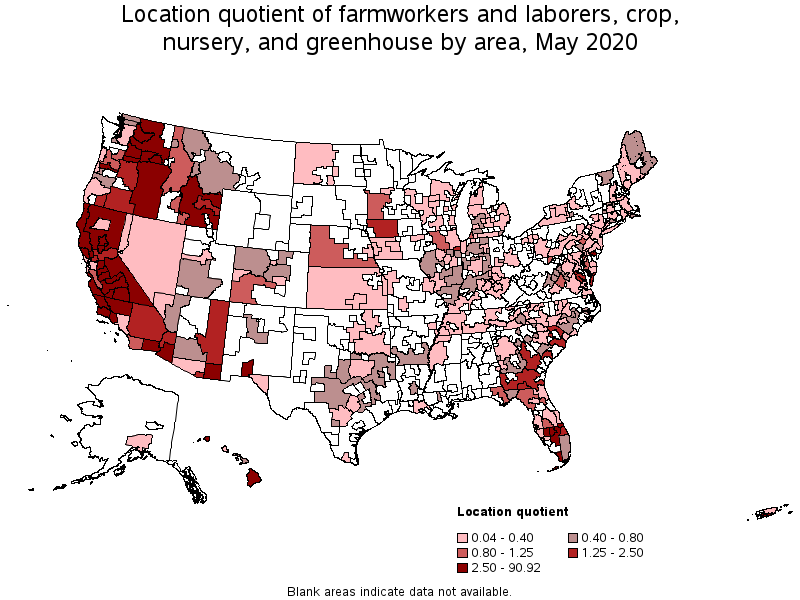
Metropolitan areas with the highest concentration of jobs and location quotients in Farmworkers and Laborers, Crop, Nursery, and Greenhouse:
| Metropolitan area | Employment (1) | Employment per thousand jobs | Location quotient (9) | Hourly mean wage | Annual mean wage (2) |
|---|---|---|---|---|---|
| Salinas, CA | 32,940 | 192.11 | 90.92 | $ 15.63 | $ 32,510 |
| Madera, CA | 6,880 | 149.80 | 70.90 | $ 13.81 | $ 28,710 |
| Visalia-Porterville, CA | 21,120 | 142.14 | 67.27 | $ 14.38 | $ 29,920 |
| Bakersfield, CA | 37,610 | 123.15 | 58.29 | $ 13.80 | $ 28,700 |
| Yuma, AZ | 6,370 | 105.01 | 49.70 | $ 13.68 | $ 28,450 |
| El Centro, CA | 5,020 | 87.50 | 41.41 | $ 14.49 | $ 30,140 |
| Merced, CA | 4,710 | 65.96 | 31.22 | $ 14.96 | $ 31,120 |
| Fresno, CA | 24,250 | 64.45 | 30.50 | $ 13.86 | $ 28,840 |
| Wenatchee, WA | 2,720 | 60.37 | 28.57 | $ 15.15 | $ 31,510 |
| Hanford-Corcoran, CA | 2,520 | 58.92 | 27.88 | $ 14.34 | $ 29,830 |
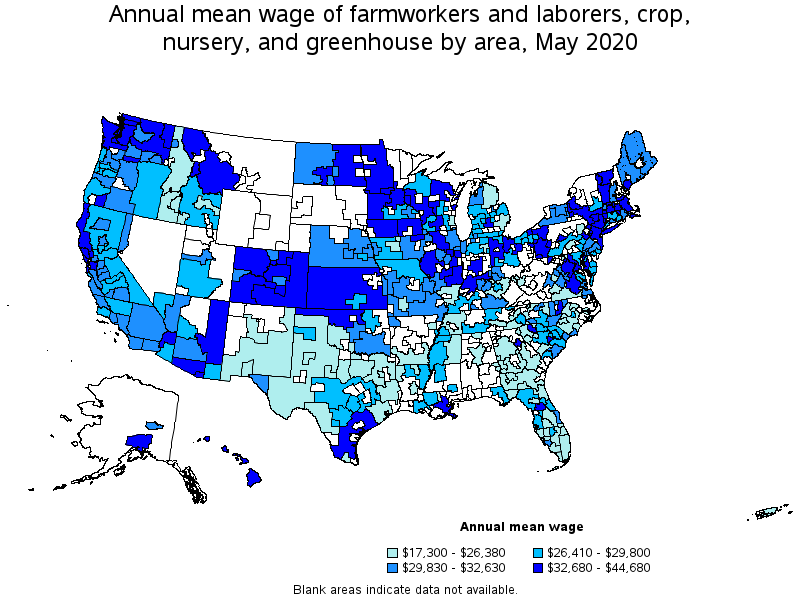
Top paying metropolitan areas for Farmworkers and Laborers, Crop, Nursery, and Greenhouse:
| Metropolitan area | Employment (1) | Employment per thousand jobs | Location quotient (9) | Hourly mean wage | Annual mean wage (2) |
|---|---|---|---|---|---|
| Champaign-Urbana, IL | 30 | 0.33 | 0.16 | $ 19.43 | $ 40,420 |
| San Francisco-Oakland-Hayward, CA | 1,750 | 0.75 | 0.35 | $ 19.31 | $ 40,170 |
| Kahului-Wailuku-Lahaina, HI | 60 | 0.91 | 0.43 | $ 19.30 | $ 40,150 |
| Urban Honolulu, HI | 240 | 0.59 | 0.28 | $ 18.96 | $ 39,430 |
| Greeley, CO | 150 | 1.40 | 0.66 | $ 18.91 | $ 39,330 |
| Madison, WI | 100 | 0.26 | 0.12 | $ 18.39 | $ 38,250 |
| Boulder, CO | 140 | 0.80 | 0.38 | $ 18.32 | $ 38,110 |
| Spokane-Spokane Valley, WA | (8) | (8) | (8) | $ 18.27 | $ 37,990 |
| Napa, CA | 2,570 | 37.18 | 17.59 | $ 18.19 | $ 37,840 |
| Lansing-East Lansing, MI | 50 | 0.28 | 0.13 | $ 18.12 | $ 37,680 |
Nonmetropolitan areas with the highest employment in Farmworkers and Laborers, Crop, Nursery, and Greenhouse:
| Nonmetropolitan area | Employment (1) | Employment per thousand jobs | Location quotient (9) | Hourly mean wage | Annual mean wage (2) |
|---|---|---|---|---|---|
| Eastern Washington nonmetropolitan area | 2,520 | 27.24 | 12.89 | $ 16.90 | $ 35,160 |
| North Valley-Northern Mountains Region of California nonmetropolitan area | 2,470 | 25.41 | 12.02 | $ 14.25 | $ 29,630 |
| Eastern Oregon nonmetropolitan area | 1,490 | 21.72 | 10.28 | $ 13.52 | $ 28,110 |
| North Coast Region of California nonmetropolitan area | 1,380 | 14.04 | 6.65 | $ 16.04 | $ 33,360 |
| South Florida nonmetropolitan area | 830 | 11.35 | 5.37 | $ 11.19 | $ 23,260 |
Nonmetropolitan areas with the highest concentration of jobs and location quotients in Farmworkers and Laborers, Crop, Nursery, and Greenhouse:
| Nonmetropolitan area | Employment (1) | Employment per thousand jobs | Location quotient (9) | Hourly mean wage | Annual mean wage (2) |
|---|---|---|---|---|---|
| Eastern Washington nonmetropolitan area | 2,520 | 27.24 | 12.89 | $ 16.90 | $ 35,160 |
| North Valley-Northern Mountains Region of California nonmetropolitan area | 2,470 | 25.41 | 12.02 | $ 14.25 | $ 29,630 |
| Eastern Oregon nonmetropolitan area | 1,490 | 21.72 | 10.28 | $ 13.52 | $ 28,110 |
| North Coast Region of California nonmetropolitan area | 1,380 | 14.04 | 6.65 | $ 16.04 | $ 33,360 |
| South Florida nonmetropolitan area | 830 | 11.35 | 5.37 | $ 11.19 | $ 23,260 |
Top paying nonmetropolitan areas for Farmworkers and Laborers, Crop, Nursery, and Greenhouse:
| Nonmetropolitan area | Employment (1) | Employment per thousand jobs | Location quotient (9) | Hourly mean wage | Annual mean wage (2) |
|---|---|---|---|---|---|
| East Central Illinois nonmetropolitan area | 100 | 0.87 | 0.41 | $ 21.48 | $ 44,680 |
| Northwest Colorado nonmetropolitan area | 100 | 0.86 | 0.41 | $ 20.88 | $ 43,430 |
| Western Pennsylvania nonmetropolitan area | (8) | (8) | (8) | $ 20.35 | $ 42,330 |
| Connecticut nonmetropolitan area | (8) | (8) | (8) | $ 20.33 | $ 42,280 |
| Coastal Plains Region of Texas nonmetropolitan area | (8) | (8) | (8) | $ 19.86 | $ 41,310 |
These estimates are calculated with data collected from employers in all industry sectors, all metropolitan and nonmetropolitan areas, and all states and the District of Columbia. The top employment and wage figures are provided above. The complete list is available in the downloadable XLS files.
The percentile wage estimate is the value of a wage below which a certain percent of workers fall. The median wage is the 50th percentile wage estimate—50 percent of workers earn less than the median and 50 percent of workers earn more than the median. More about percentile wages.
(1) Estimates for detailed occupations do not sum to the totals because the totals include occupations not shown separately. Estimates do not include self-employed workers.
(2) Annual wages have been calculated by multiplying the hourly mean wage by a "year-round, full-time" hours figure of 2,080 hours; for those occupations where there is not an hourly wage published, the annual wage has been directly calculated from the reported survey data.
(3) The relative standard error (RSE) is a measure of the reliability of a survey statistic. The smaller the relative standard error, the more precise the estimate.
(7) The value is less than .005 percent of industry employment.
(8) Estimate not released.
(9) The location quotient is the ratio of the area concentration of occupational employment to the national average concentration. A location quotient greater than one indicates the occupation has a higher share of employment than average, and a location quotient less than one indicates the occupation is less prevalent in the area than average.
Other OEWS estimates and related information:
May 2020 National Occupational Employment and Wage Estimates
May 2020 State Occupational Employment and Wage Estimates
May 2020 Metropolitan and Nonmetropolitan Area Occupational Employment and Wage Estimates
May 2020 National Industry-Specific Occupational Employment and Wage Estimates
Last Modified Date: March 31, 2021